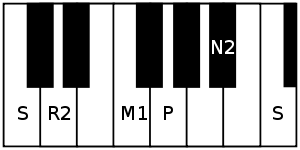Madhyamavati
Madhyamavati (madhyamāvati) is a rāga in Carnatic music (musical scale of South Indian classical music). It is an audava rāga (or owdava rāga, meaning pentatonic scale), as it does not have all the seven musical notes (swaras). It is a janya rāga (derived scale). The equivalent of Madhyamavati in Hindustani music is Madhumad Sarang.[1]
| Arohanam | S R₂ M₁ P N₂ Ṡ |
|---|---|
| Avarohanam | Ṡ N₂ P M₁ R₂ S |
| Carnatic music |
|---|
Tanjavur-style Tambura |
| Concepts |
| Compositions |
| Instruments |
|
It is considered a very auspicious rāgam and every Carnatic music concert ends with either a song in Madhyamavati or the ending of the last song is sung in this rāgam.[2] It is very suitable for elaboration and exploration due to even spacing of notes. The scale uses the first three notes of the cycle of fifths S, P and R2 and fourths S, M1 and N2.[2]
Madhyamavati is considered a janya rāga of Kharaharapriya, the 22nd Melakarta rāga, though it can be derived from other melakarta rāgas, Charukesi, Natabhairavi or Harikambhoji, by dropping both gāndhāram and dhaivatam.
Structure and Lakshana

Madhyamavati is a symmetric rāga that does not contain gāndhāram or dhaivatam. It is a pentatonic scale (audava-audava rāgam[1][2] in Carnatic music classification - audava meaning 'of 5'). Its ārohaṇa-avarohaṇa structure (ascending and descending scale) is as follows (see swaras in Carnatic music for details on below notation and terms):
- ārohaṇa : S R₂ M₁ P N₂ Ṡ[lower-alpha 1]
- avarohaṇa : Ṡ N₂ P M₁ R₂ S[lower-alpha 2]
This scale uses the notes chatushruti rishabham, shuddha madhyamam, panchamam and kaisiki nishadam. Madhyamavati is considered a janya rāga of Kharaharapriya, the 22nd Melakarta rāga, though it can be derived from other melakarta rāgas, Charukesi, Natabhairavi or Harikambhoji, by dropping both gāndhāram and dhaivatam.
Popular compositions
Madhyamavati rāgam lends itself for extensive elaboration and exploration and has many compositions. Here are some popular kritis composed in this scale.
- Bhagyada Lakshmi Baaramma by Purandara Dasaru in Kannada
- Nyayiru Kayathu, Ancient Tamil Kuṟuntokai poetry by Poet Kayamanar in Sandham- Symphony Meets Classical Tamil by Composer Rajan
- Allagallalla, Nadupai and Muchchada brahma and Rama Katha Sudha by Tyagaraja in Telugu
- Dharmasamvardhinim, mahatripurasundari mamava jagadishvari by Muthuswami Dikshitar in Sanskrit
- Palinchu kamakshi by Shyama Sastri in Telugu
- Kosalendra mamavamita,bhavaye padmanabham iha , Sarasamukha sarasijanabha by Swathi Thirunal
- Ramabhirama by Mysore Vasudevachar in Sanskrit
- Sharavanabhava Guhane and Karpagame Kan by Papanasam Sivan in Tamil
- Akhilanda Nayaka by Thulasivanam in Sanskrit
- Sri Chamundeswarim bhajeham santatam by Jayachamarajendra Wodeyar in Sanskrit
- Vidachi sukhimpave and Devi parvati by Saint Gnanananda Teertha (Ogirala Veera Raghava Sarma) in Telugu
- Shankari ShrI Rajarajeshvari ,Aadaadhu Ashangaadhu vaa by Oothukkadu Venkata Kavi in Tamil
- Tuning of Adivo Alladivo and Marali Marali Jayamangalamu by Annamacharya in Telugu
- Santoshi Mata by Kalyani Varadarajan
- Shri Parameshwaram Chinmaya tava,Shri Rama Jaya Bhuma,Shrimat Tripurasundari Amba by Muthiah Bhagavatar
- Bhajamahe Shri Tripurasundari by Hari Sundareswara Sharma in Sanskrit
- Harivarasanam by K. Janaki Amma in Sanskrit
Film Songs
Language:Tamil
Related rāgas
This section covers the theoretical and scientific aspect of this rāgam.
Graha bhedam
Madhyamavati's notes when shifted using Graha bhedam, yields 4 other major pentatonic rāgas, namely, Mohanam, Hindolam, Shuddha Saveri and Udayaravichandrika (also known as Shuddha Dhanyasi).[2] Graha bhedam is the step taken in keeping the relative note frequencies same, while shifting the shadjam to the next note in the rāga. For more details and illustration of this concept refer Graha bhedam on Mohanam.
Scale similarities
- Kedaragaula is a rāgam\ which has the ascending scale of Madhyamavati and descending scale of Harikambhoji. Its ārohaṇa-avarohaṇa structure is S R₂ M₁ P N₂ S: S N₂ D₂ P M₁ G₃ R₂ Ṡ
- Manirangu is a rāga which has gāndhāram in the descending scale, while all other notes in both the ascending and descending scale are same as Madhyamavati. Its ārohaṇa-avarohaṇa structure is Ṡ R₂ M₁ P N₂ S: S N₂ P M₁ G₂ R₂ Ṡ
- Revati is a rāga which has shuddha rishabham in place of chatushruti rishabham in the scale, while all other notes are same as Madhyamavati. Its ārohaṇa-avarohaṇa structure is Ṡ R₁ M₁ P N₂ S: S N₂ P M₁ R₁ Ṡ
- Brindāvana Sāranga is also a rāga that has some similarities in scale with Madhyamavati. Its ārohaṇa-avarohaṇa structure is Ṡ R₂ M₁ P N₃ S: S N₂ P M₁ R₂ G₂ Ṡ
- Andolika is an asymmetric rāga which has chatusruti dhaivata in place of panchama only in the descending scale, while all other notes are same as Madhyamavati. Its ārohaṇa-avarohaṇa structure is Ṡ R₂ M₁ P N₂ S: S N₂ D₂ M₁ R₂ S
Notes
- Alternate notations:
- Hindustani: S R M P Ṉ Ṡ
- Western: C D F G B♭ C
- Alternate notations:
- Hindustani: Ṡ Ṉ P M R S
- Western: C B♭ G F D C
References
- Raganidhi by P. Subba Rao, Pub. 1964, The Music Academy of Madras
- Ragas in Carnatic music by Dr. S. Bhagyalekshmy, Pub. 1990, CBH Publications